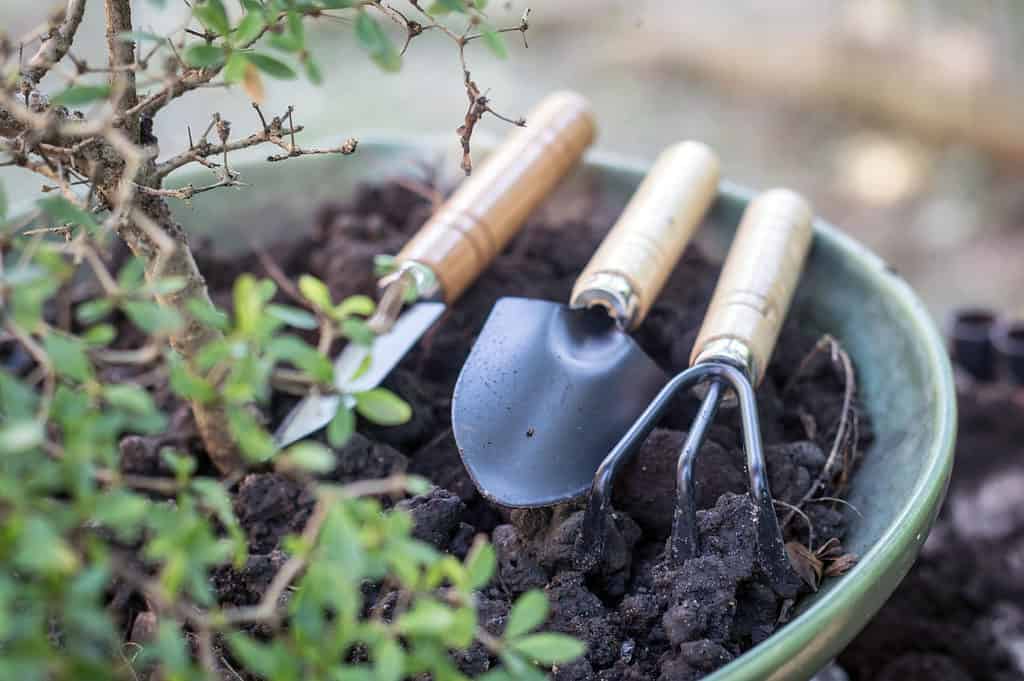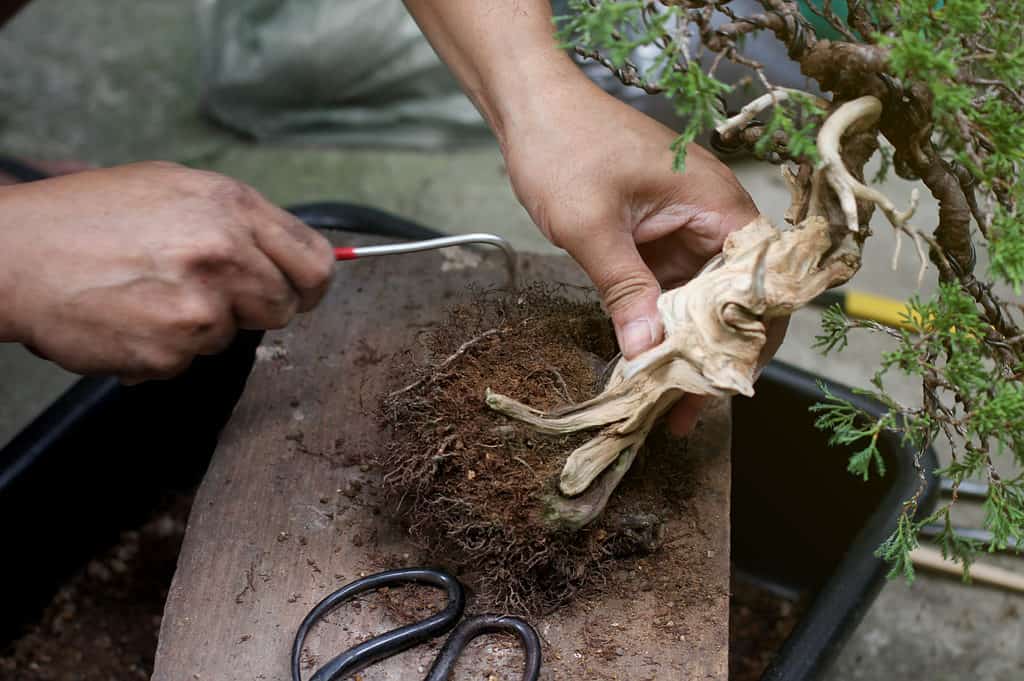If you want to begin cultivating and caring for your own trees in miniature, you should know that there is very specific Bonsai tree soil. Given the compact and small containers needed to successfully grow a Bonsai tree, choosing a potting medium that supports this style of growth is key. But what do you need to know about Bonsai tree soil, and how can you best pot your new Bonsai tree once you bring it home?
In this article, we will address everything you need to know about Bonsai tree soil, including all of the ways it differs from a standard potting soil mixture. We will give you some tips for what components to include if you want to make your own soil blend. Plus, we’ll talk about what qualities you should be shooting for if you want good Bonsai tree soil. Let’s get started!
How is Bonsai Tree Soil Different from Regular Potting Soil?

©wonderisland/Shutterstock.com
The soil necessary to promote healthy Bonsai tree growth habits is very different from any type of regular potting soil. Growing miniature trees and landscapes in a limited container means that you need different materials than the average plant, especially compared to the soil requirements of houseplants or vegetable gardens!
Bonsai trees are also literally trees or shrubs. These plants grow in very different ways from other plants, especially when confined to a container. This isn’t to say that growing a Bonsai tree in a compact container is harmful to it; far from it! However, understanding that a Bonsai tree needs more nutrients than the average plant given its small living quarters is important.
Therefore, Bonsai tree soil differs from regular potting soil in almost every way. In fact, using standard potting soil is likely to spell death for the average Bonsai tree, given its lack of fast drainage and proper nutrients for tree growth. Your Bonsai tree is capable of thriving in a small container, but only if the soil supports its long-term, healthy growth.
Qualities Needed for Good Bonsai Tree Soil

©qSPOoKYp/Shutterstock.com
While some soil components will depend on the type of Bonsai tree that you have, all Bonsai trees need a few distinct qualities in their soil in order to thrive. You are the only source of nutrients and life for your Bonsai tree, something that is important to keep in mind if you are a beginner in Bonsai tree care! Here are some must-have qualities for any good Bonsai tree soil.
Fast-Draining
Standing or slow-draining water is the fastest way to kill any type of Bonsai tree. Therefore, choosing soil components or mixtures that promote fast drainage is the best place to begin. Some ready-made soil mixtures advertise this quality, but choosing a soil mixture that specifically mentions being used for Bonsai trees is the only way to go.
There are a number of components that ensure fast-draining soil, including organic and inorganic materials. Ensuring that your Bonsai tree roots are healthy is the only way to encourage long-term, miniature growth. While you’ll likely need to water your Bonsai tree often, depending on the season, the water shouldn’t be lingering in the pot!
Aerated and Rocky
Going hand-in-hand with fast-draining qualities, choosing soil components that are aerated and rocky is a good idea. Whether you have a flowering Bonsai tree, an evergreen pine, or a fruit Bonsai tree, rocky soil components will help the roots of your tree thrive. When you think about how trees grow in nature at their full size, their roots often grow over rocks or stones. Mimicking this natural environment, no matter how small, likely helps your Bonsai tree thrive!
Aerated soil can be tricky to determine. However, the roots of all Bonsai trees (and most plants, for that matter!) require oxygen in order to live. Typically, rocks and other inorganic materials can help promote oxygen within a Bonsai tree habitat. However, some options are better than others- but more on that soon!
Some Moisture Retention
Contrary to what has been discussed already, Bonsai tree soil should have some level of moisture retention. The majority of Bonsai trees cannot be allowed to dry out completely, as this will also harm most tree species. The amount of water retention that trees maintain in nature needs to be replicated, even in miniature.
Thankfully, the majority of organic materials found in Bonsai tree soil mixtures lend well to moisture retention. It’s likely better for you to err on the side of less moisture retention rather than more. You can always add water to your Bonsai tree when it needs it. It’s far harder to take water away, especially if your soil was not well-draining to begin with!
Components of Bonsai Tree Soil

©qSPOoKYp/Shutterstock.com
There are countless possible Bonsai tree soil components and combinations for you to try. Many Bonsai tree artists make their own soil so that they can fully control the moisture and oxygen levels within the container itself. However, some premade options may work well for you, especially if you are just beginning with a simple ficus Bonsai tree. Regardless, here are some common components found in Bonsai tree soil.
Clay
With an ideal amount of water retention and drainage, there are a number of clay products you can incorporate into your Bonsai tree container. Often referred to as volcanic soil, clay components are typically necessary for the average Bonsai tree soil. Keep in mind that all Bonsai tree soil will need to be refreshed annually or every other year, especially if you use clay. Some common clay types for Bonsai trees include:
- Akadama (from Japan)
- Seramis (from Germany)
- Kanuma (from Japan)
Stones or Rocks
While clay helps you maintain moisture levels in your soil, rocks and different types of stones will ensure that your soil is fast-draining. This is likely the main component to help with your Bonsai tree’s overall health, especially if you live in a location where your tree will receive plenty of rain. There are also many different types of stones to incorporate into your Bonsai tree soil, including:
- Perlite
- Lava rocks (in various sizes)
- Pumice
- Grit and sand
- Gravel
Organic Material
Many Bonsai tree artists advocate against using organic material in a Bonsai tree container due to the overall moisture retention qualities associated with organic material. However, some organic material is necessary for any and all plants, including Bonsai trees. When used sparingly, the following organic materials work well in Bonsai tree soil:
- Peat or moss
- Bark
- Organic soil or compost
- Decomposed leaves
Premade Bonsai Soil Mixtures vs Mixing Your Own

©Gheorghe Mindru/Shutterstock.com
You can always use a premade Bonsai tree mixture rather than mixing your own, but some mixtures might not work with certain plant or tree types. Knowing what type of tree or plant you have before choosing any soil type is a good idea, including the pH requirements. You may also find that the tree you have prefers certain organic or inorganic materials over others. Succulent Bonsai trees will require more fast-draining elements compared to other plant specimens, for example.
There are many different premade Bonsai soil brands to consider. Choosing a premade mixture and then continuing to add other elements to it may also work well for you. Keep in mind that Bonsai trees need repotting every year or every other year on average, so you’ll likely need all of the soil you can get!
With practice and plenty of research, it should be easier than you think to find a soil medium that works well for your Bonsai tree!
Up Next:
- How to Properly Place a Bonsai Tree
- Bonsai Styles: Everything You Need to Know
- Discover the Oldest Bonsai Tree and Where to See it
The post The Best Soil for Bonsai Trees appeared first on AZ Animals.
from Animal News, Facts, Rankings, and More! - AZ Animals https://ift.tt/0vdzsg2